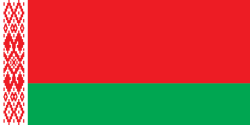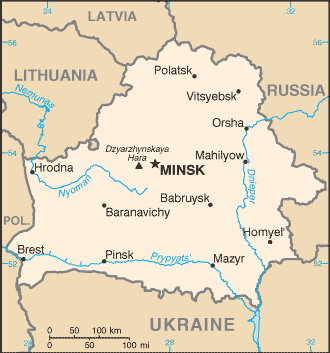Belarus
Related Categories:
 Flag of Belarus
Flag of BelarusRed horizontal band (top) and green horizontal band one-half the width of the red band; a white vertical stripe on the hoist side bears Belarusian national ornamentation in red. |
 Belarus National Symbols - Fotw
Belarus National Symbols - FotwByelorussia was before 1917 a cultural and territorial expression with no governmental character.
www.fotw.us/
Belarus is landlocked, relatively flat, and contains large tracts of marshy land. Lakes and rivers punctuate the country.
en.wikipedia.org/
While archeological evidence points to settlement in today's Belarus at least 10,000 years ago, recorded history begins with settlement by Baltic and Slavic tribes in the early centuries A.D. With distinctive features by the ninth century, the emerging Belarusian state was then absorbed by Kievan Rus' in the 9th century. Belarus was later an integral part of what was called Litva, which included today's Belarus as well as today's Lithuania. Belarus was the birthplace of the Grand Duchy of Lithuania. Belarusian was the state language of the Grand Duchy until 1697, in part owing to the strong flowering of Belarusian culture during the Renaissance through the works of leading Belarusian humanists such as Frantzisk Skaryna. Belarus was the site of the Union of Brest in 1597, which created the Greek Catholic Church, for long the majority church in Belarus until suppressed by the Russian empire, and the birthplace of Thaddeus Kosciuszko, who played a key role in the American Revolution. Occupied by the Russian empire from the end of the 18th century until 1918, Belarus declared its short-lived National Republic on March 25, 1918, only to be forcibly absorbed by the Bolsheviks into what became the Soviet Union (U.S.S.R.). Suffering massive population losses under Soviet leader Josif Stalin and the German Nazi occupation, Belarus was retaken by the Soviets in 1944. It declared its sovereignty on July 27, 1990, and independence from the Soviet Union on August 25, 1991. It has been run by the authoritarian Alexander Lukashenko since 1994.
www.state.gov/r/
Introduction
About
Contact
Symbols in The News
Interpret this Symbol
AAC
African
AI
Alchemy
Alphabets
Ancient
Animal Symbolism
Architecture
Art
Articles
Astrology
Baha'i
Blissymbolics
Blueprint Symbols
Buddhist
Celtic Symbols
Cemetery
Chinese Symbols
Christian
Circle
City
Codes
Color
Conlangs
Crop Circles
Danger
Da Vinci Code
Designing Logos
Dictionaries
Dreams
Education
Egyptian Symbols
Electrical
Emoticons
Find Images
Fonts
Food
Fraternity
Hamsa
Healing
Heraldry
Hermetic
Highway Signs
Hindu
History
Hobo
Holiday
Icons
iConji
Islamic
Jain Symbols
Japanese, Kanji
Jewish
Justice
Law
Literary Symbolism
Mandalas
Map
Masonic
Math, Number
Meaning of Names
Medical
Middle East
Military
Miscellaneous
Money
Music
Mythology
Native American
Playing Cards
Power
Psychology
QiQiiKhu
Reiki
Religious
Runes, Norse
Sacred Geometry
Scientific
Science Fiction
Sorority
Sports
Symbols in the News
Tattoos
ThirteenSymbols
Tree of Life
Ursprache
Videos
Visual Languages
Weather
Web Codes
Wicca
Words
Writing Systems
Braille
Coinherence
Coptic
Cuneiform
Easter Island
Etruscan
Happy Human
Hebrew
Kokopelli
Linear B
Lotus
Love Symbols
Mandorla
Moon Alphabet
Nine Pointed Star
Om
Oz
Phonetic
Scarab Beetle
Silent
Theosophy
Unifon
About
Contact
Symbols in The News
Interpret this Symbol
AAC
African
AI
Alchemy
Alphabets
Ancient
Animal Symbolism
Architecture
Art
Articles
Astrology
Baha'i
Blissymbolics
Blueprint Symbols
Buddhist
Celtic Symbols
Cemetery
Chinese Symbols
Christian
Circle
City
Codes
Color
Conlangs
Crop Circles
Danger
Da Vinci Code
Designing Logos
Dictionaries
Dreams
Education
Egyptian Symbols
Electrical
Emoticons
Find Images
Fonts
Food
Fraternity
Hamsa
Healing
Heraldry
Hermetic
Highway Signs
Hindu
History
Hobo
Holiday
Icons
iConji
Islamic
Jain Symbols
Japanese, Kanji
Jewish
Justice
Law
Literary Symbolism
Mandalas
Map
Masonic
Math, Number
Meaning of Names
Medical
Middle East
Military
Miscellaneous
Money
Music
Mythology
Native American
Playing Cards
Power
Psychology
QiQiiKhu
Reiki
Religious
Runes, Norse
Sacred Geometry
Scientific
Science Fiction
Sorority
Sports
Symbols in the News
Tattoos
ThirteenSymbols
Tree of Life
Ursprache
Videos
Visual Languages
Weather
Web Codes
Wicca
Words
Writing Systems
Braille
Coinherence
Coptic
Cuneiform
Easter Island
Etruscan
Happy Human
Hebrew
Kokopelli
Linear B
Lotus
Love Symbols
Mandorla
Moon Alphabet
Nine Pointed Star
Om
Oz
Phonetic
Scarab Beetle
Silent
Theosophy
Unifon
